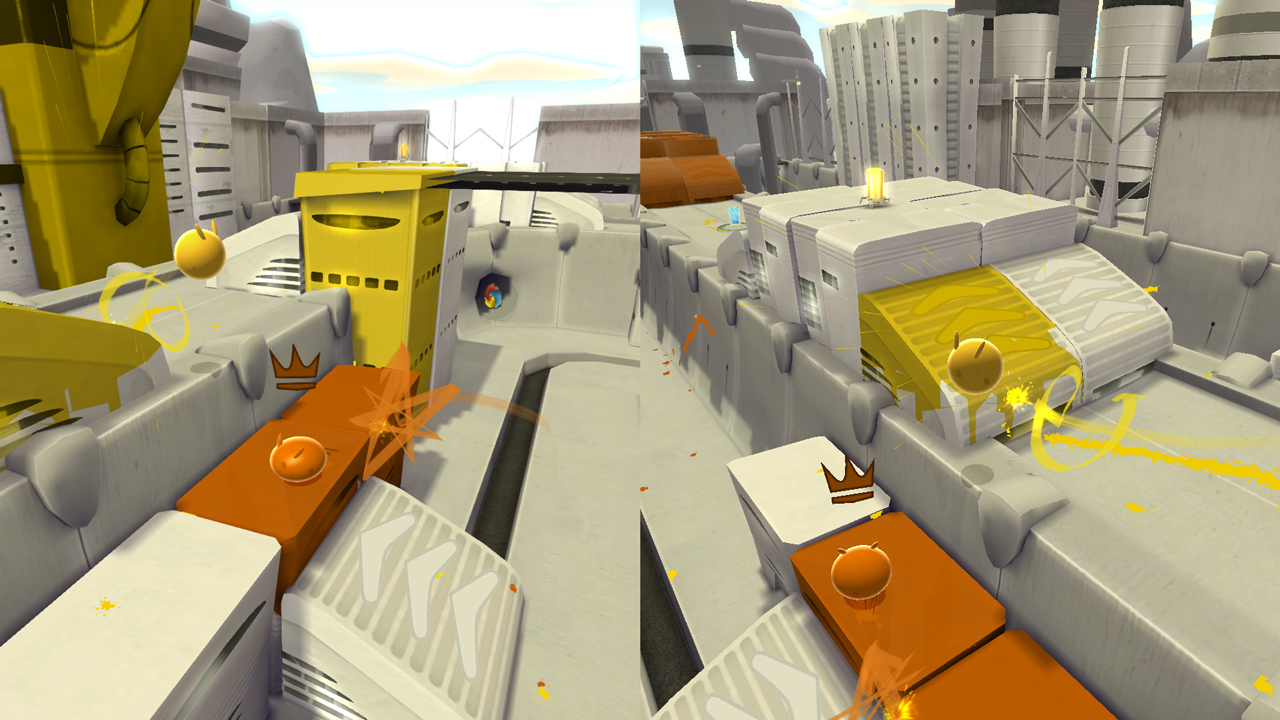Sometimes it feels like Nintendo systems are adverts for craft supplies. From Yoshi’s yarn visage to Kirby’s adventures in painting, Splatoon’s inky fun and Labo’s cardboard construction I can imagine they’re doing a lot to improve the kid’s arts/crafts scene. So in many ways, it’s absolutely perfect that De Blob has returned to the Ninty side. Originally released in 2008 for the Wii, De Blob was an under-rated smash with a rebellious anti-establishment vibe which never really entered the public consciousness in a big way. It was ported to other consoles over the years and eventually received a remastered recently on other consoles. Now, as it’s released on the Nintendo Switch we need to answer the question; “10 years on, does it still hold up?”

The plot of De Blob has a lot of punk vibes to it. Set on a (previously) colourful alien world, you play as de Blob as he fights to liberate Chroma city from the oppressive INKT Corporation, who have turned it black and white. With your team of rebels, you have to splat around destroying paint-bots, absorbing the colour they have stolen and returning it to the buildings and populace of the world. The INKT Corporation, a military dictatorship, is beautifully characterised with a monochrome look and a comedic slant to it’s War on Colour. The Inkies are intimidating, sure, taking inspiration from a variety of oppressive regimes, but the cutscenes they star in add a big blob of slapstick incompetence to their design which makes them almost agreeable. In contrast, the Colour underground is lively and bright, with so much charm it almost leaks out. Whilst I’m unsure why their leader is the only person in the city with facial hair, each character has a distinct personality and role which adds so much to the overall feel of the world. Add to this a graffiti-like inspiration almost reminiscent of The World Ends with You and you’re left with a group that you’re actively rooting for from the start and overjoyed to be part of. Whilst the plot doesn’t evolve much from this starting point with De Blob and his friends simply slowing taking back the city and liberating the Raydians, these initial starting points inform everything about the game and give it a sense of purpose that drives it throughout.
The game is split up into a number of levels, each with a loose time limit. The aim is simply to hop, roll and splat around each part of the city covering buildings, creatures, and plants of different colours, with extra time offered for saving Raydians and completing objectives. You begin blank; a ball of living water; and “ink” up by destroying primary paint-carrying robots and absorbing the liquid. You change the colour of de Blob by combining different primary colours, leading to 7 different possible colours. Each level is full of hundreds of objects to colour and a variety of collectibles and missions. Missions are given by the different members of the Colour underground with a few different objectives including colouring certain buildings in a certain way or traversing the map. The levels also include a variety of obstacles which literally suck the colour out of you and return the world to a monochrome state. As the game ramps up, these obstacles become more numerous and the Inkies appear in greater numbers and with a greater arsenal. Despite the years since release nothing has really done anything similar, and it’s damn fun, despite the fact it can get quite repetitive at times over the course of the 9-12 hours of the main campaign. It’s a colourful, joyous experience that I found genuinely relaxing, and can see myself dipping into on switch over and over in order to ensure every part of every district is covered completely in paint.

Part of what made the game so engaging and relaxing was the excellent sound design. At the start of each level, you can choose a mood which mixes up the background soundtrack in an engaging manner. The backing music slowly builds as you recolour the world until it becomes a gorgeous cacophony. It’s dynamic and really adds to the immersion of a world returning to how it should be, adding musical evolution to the stunning visual evolution.
The aesthetic itself is stunning both before and after you colour between the lines, and it’s fantastic to see the world transfer from beautiful bleakness to colourful insanity. Yes, you can occasionally tell how old the game truly is, but the remaster process has made the majority of the game pop as if designed for Switch. Granted, the art style does lend itself well to updates, but regardless it’s been beautifully brought up to date.

The actual port is pretty damn good; all the features from the original have been brought across including the multiplayer mode and free paint, and from my experience, it ran consistently and smoothly both in handheld and on my TV. It’s a wonderful re-release which just shows how well an under-rated, almost forgotten game can do if re-released well. It looks, sounds and feels right on Switch, despite the long nature of the levels, and that’s honestly exactly what I was in a modern release.
In conclusion, De Blob is good. Seriously good. I’d argue it’s one of the best remasters I’ve seen on the Nintendo Switch; bringing a game I have not played before and given it the love it deserves to make it feel like an experience from the last few years. If you haven’t played De Blob, or you did originally and loved it I can highly recommend that you pick up the controls of de Blob and smash yourself into a wall to make it colourful.
Or, y’know, just buy the game?








You must be logged in to post a comment.